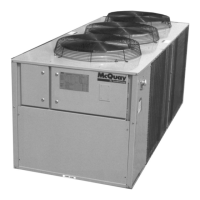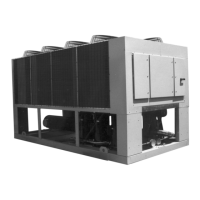IOM 686 AGZ 030A through 065A 81
6. Reconnect the analog input ribbon cable. Cycle power to the controller and check the power fuses.
If both fuses are intact, go to step 7.
If either fuse blows, check the ADI board, the connecting ribbon cable, and the field wiring for
shorts. Any of these may be defective. Try repeating this step after removing or swapping the ADI
board.
7. Reconnect the digital input ribbon cable. Cycle power to the controller and check the power fuses.
If both fuses are intact, go to step 8.
If either fuse blows, check the ADI board, the connecting ribbon cable, and the field wiring for
shorts. Any of these may be defective. Try repeating this step after removing or swapping the ADI
board.
8. Reconnect the digital output ribbon cable to the MCB. Cycle power to the controller and check
the power fuses.
If both fuses are intact, go to step 9.
If either fuse blows, check Output Board and the connecting ribbon cable. Either of these may
be defective.
9. If there are any AOX-4 boards, reconnect the expansion bus ribbon cable to the MCB; otherwise,
go to step 10. Cycle power to the controller and check the power fuses.
If both fuses are intact, go to step 10.
If either fuse blows, check the analog output expansion modules (if any), the connecting ribbon
cables, and the field wiring for shorts. Any of these may be defective.
10. With circuit breaker CB1 open, measure the resistance between field terminals “DC-GRD” and “5
Vdc.” It should be greater than 20 ohms.
If the resistance is greater than 20 ohms, go to step 11 if the controller is equipped with at least
one AOX-4 board or a modem. Otherwise, the problem is indeterminate. Obtain factory service.
If the resistance is less than 20 ohms, it is likely that the keypad/display, the Output Board or an
external (field supplied) load is excessively loading the MCB’s 5 Vdc power supply. Isolate the
problem by taking resistance measurements on each of these devices with the wiring disconnected.
The resistance across the power input terminals on the keypad/display (G and 5V) should be close
to infinite. The resistance across the power input terminals on the Output Board (+ and –) should
not be less than 3000 ohms. If the component resistance’s are proper, check the resistance of the
field supplied loads (if any) and check the wiring and connections throughout the 5 Vdc power
supply circuit.
11. Disconnect the connector plugs from the modem and the power plug from all AOX-4 boards (as
applicable). With circuit breaker CB1 open, measure the resistance between field terminals “DC-
GRD” and “13 Vdc.” It should be infinite.
If the resistance is infinite, go to step 12.
If the resistance is not infinite, a short exists somewhere in the 13 Vdc power supply wiring.
12. Reconnect the Aux/Out connector plug to the MCB. If there’s a modem, reconnect its AMP plug
to port A. With circuit breaker CB1 open, measure the resistance between field terminals “DC-
GRD” and “13 Vdc.” It should steadily rise to a value greater than 5000 ohms (within
approximately 30 seconds).
If the resistance rises above 5000 ohms, go to step 13.
If the resistance does not rise above 5000 ohms, the MCB is defective.
13. One at a time, reconnect the modem and each AOX-4 board (as applicable). Each time a
component is reconnected, measure the resistance between field terminals “DC-GRD” and “13
Vdc.” It should steadily rise to a value greater than 5000 ohms.
If the resistance rises above 5000 ohms, repeat this step until the modem and all AOX-4 boards
(as applicable) have been checked out. If the problem persists, it is indeterminate. Obtain factory
service.
If the resistance does not rise above 5000 ohms, the modem or the AOX-4 board just connected is
defective. (With the power plug disconnected, the resistance across an AOX-4 board’s “DC” and
“G” terminals should not be less than 3 million ohms.)
